#Pilgrimage To The West
Explore tagged Tumblr posts
Text
Journey to the West: Prequel to Tripitaka (2018) 西游·三藏前传

Country/Region of Production: Mainland China Date: 2018-08-02 (Mainland China) Duration: 65 minutes Also known as: Journey to the West / Pilgrimage To The West / 西游释厄传 Type: Reimanging
Summary:
Jiang Liuer had to go through ten reincarnations to become Tang Monk. In the tenth reincarnation, Jiang Liuer was reincarnated in a temple. After accidentally letting a demon go, he was expelled from the sect by his master and went down the mountain. At the foot of the mountain, he saw the colors of the human world, participated in the Voice of Tang Dynasty, and met his beloved woman. Along the way, he was secretly protected by Sun Wukong. The four, master and apprentices, had karma in their previous lives, and later they cultivated to the West to obtain the scriptures. On the way to the West to obtain the scriptures, they met the woman of their previous life. Did Tang Monk love in his previous life? Was the Queen of the Kingdom of Women who later went to the West to obtain the scriptures a fate owed by him in his previous life?
Source: https://movie.douban.com/subject/30284862/
Link: N/A
#Journey to the West: Prequel to Tripitaka#西游·三藏前传#jttw media#Journey to the West#Pilgrimage To The West#西游释厄传#jttw movie#movie#live action#lost media#reimaging#reimagining#prequel#sun wukong#tang sanzang#sha wujing#zhu bajie#queen of women's kingdom
17 notes
·
View notes
Text
It's because you're always on that damn pilgrimage
#fate#fate grand order#lostbelt 6#avalon le fae#this post is fun#because everytime i reblog it#i get a different crowd#first time? avalon le fae girlies (target audience)#second? journey to the west#third? Final Fantasy X baby (never stop dancing)#just to say. i love y'all#we'll get out of that pilgrimage tidus wukong
4K notes
·
View notes
Text
I have half after 3 HOURS
why am i so slow at drawing digitally
I blame my fingers


#jttw#journey to the west#sun wukong#monkey king#triptaka#Xuanzang#Sanzang#Vine#Digital art#Ignore the background it is ugly af#I had to look up what Sun Wukong wears on the pilgrimage and I think it turned out cute#Well kinda#Speaking of Pilgrims#I have a core memory of my art teacher walking past me in the corridor and saying *unprompted* 'Nat you look like a medival pilgrim'#AND JUST WALKED AWAY#LIKE WHAT DID I DO TO YOU#I swear he had a vendetta against me in my last few weeks in his class#Like he made a joke about this kid I don't like and I let out the slightest giggle and he went 'oh Nat found it funny'#The kid gave me the worst stank eye you've ever seen 😭#And he mocked me when I banged my foldy cane on the ground to see if it was together probarly#Had this roll of cardboard and repeated the motion while trying to make eye contact with me#I was terrified and clung to my friend like a barnacle when we made our escape#She reminds me of it all the time#Cause she HORRID#I love her tho
6 notes
·
View notes
Text
Journey to the West Chapter 22
Guanyin telling Sandy to keep the Monk Skulls back in chapter 8:

In this chapter of Journey to the West with @journeythroughjourneytothewest we finally get the whole gang together. So let's get into it shall we?
So the gang manages to make it pass Yellow Wind Mountain and time passes without incident until they arrive at yet another scary looking river that is apparently 800 miles wide. And with the river comes a problem, while Monkey and Pigsy would be able to cross it no problem, Tripitaka can't and there aren't any boats or anything around either.
Anyways Tripitaka manages to come across a stone slab and they learn that this river is apparently called the 'Flowing Sand River'. However as they are all gathered around for family reading time- a monster springs out of the water and makes a B-line for Tripitaka. Fortunately Monkey is all to use to random monsters trying to take a bite out of his master- so he manages to grab him and run to hire ground while Pigsy faces off against the monster.
Pigsy seems about evenly matched against the monster, but soon enough, Monkey gets bored playing bodyguard for Tripitaka and leaps into the fight- and ends it instantly by whacking the monster on the head with his staff which startles him so badly that he immediately retreats back into the river.
Pigsy meanwhile takes exception to Monkey interrupting his fight because he was *this* close to sealing the deal. But Monkey just shrugs and says he was bored and wanted to play to. Despite this though the two make their way back to Tripitaka in high spirits. However even though the monster isn't bothering them anymore, they still have to solve the original problem, which is to get Tripitaka safely across the river. So the group decides that the best way to get across is to have the monster of the river help Tripitaka across.
And here we also learn about one of Sun Wukong's few weaknesses- he's not good at fighting under water. If he just needs to transverse it- that's one thing, he can just use the water repelling charm or change into a sea creature, but actually fighting underwater is another matter. Luckily, Pigsy can fight underwater, he was a Marshal of the Heavenly River back when he was a god after all. But while Pigsy might be able to face the monster one on one, he's worried about the monster having allies in the river and ganging up on him. So they come up with a plan to have Pigsy lure him out of the water so that Monkey can help him. So with their strategy in place Pigsy heads out, parting the water like Moses to make a path for himself into the river.
So, Pigsy and the monster face off once again- this time in the river, and we get to learn this mysterious monster's tragic backstory. Which basically amounts to: He was the Curtain Raising Captain for the Jade Emperor in heaven, but during the Festival of Peaches he broke a crystal cup and was banished to the Flowing Sand River where he has been spending his days eating random passerby's.
Eventually during their fight Pigsy pretends to flee in defeat to lure the monster to the surface like planned. Unfortunately though Monkey is so eager to fight that he jumps the gun, immediately nailing the monster in the head once again- only to have the monster NOPE back into the water again as soon as he see's Monkey coming. So Pigsy starts yelling at Monkey for being to impulsive, but Monkey just laughs him off and suggests they go talk with Tripitaka.
So they have a brief team meaning where Pigsy tells them about the fight and how the monster is about his equal. They then decide to worry about the situation tomorrow and just rest for now so Monkey takes off to get some food for Tripitaka and is back in no time. When he see's how fast he returned Tripitaka suggests they just ask the family he got the food from on how to cross the river. But Monkey says they are unlikely to know anything about his river considering they live seven thousand miles away from here. And he takes the opportunity to brag about his cloud somersault.
And Pigsy then points out something interesting why doesn't Sun Wukong just carry him across the river if he could make the distance in a single jump? Monkey however points out the Pigsy also knows how to ride the clouds, so why doesn't he carry him across? So Pigsy answers his own question- as far as the rules of magic goes a mortal is as heavy as a mountain. The only way Tripitaka is getting through this journey is if he takes every single step of it himself. Pigsy and Monkey are there to protect him, but they can't do the journey for him, or receive the scriptures from the Buddha. And I feel like this conversation justifies and answers every question about why this journey is so long and hard despite how powerful Sun Wukong and the others are.
So the next morning they decide to try the plan again but this time with Monkey not being so impulsive. So Pigsy dives back into the water and has a great time comparing weapons and fighting the monster. This time when Pigsy feigns defeat to lure the monster to the surface though the monster doesn't fall for it since he'd really rather not take another beating from Sun Wukong. Seeing him refuse to come out, Monkey decides to try and fight him anyways, but as soon as the monster see's him coming, he flees deeper into the water.
So the gang gathers together for yet another team meeting and I get to add another number to Tripitaka's cry count due to his worry on how to cross the river. Seeing as how Pigsy can't beat the monster on his own, and how their plan to lure him out is a wash, Monkey decides to pull out his trump card- asking Guanyin for help. So leaving Tripitaka in Pigsy's care, Sun Wukong takes off to the South Sea to get Guanyin's help.
So Monkey tells Guanyin all about their troubles, and probably makes her sigh in exasperation because the monster of the Flowing Sand River... is the Curtain Rising Captain that Guanyin recruited to help them on their Journey, because apparently despite their problems acquiring the horse and Pigsy, Monkey still isn't telling the right people about their Scripture Mission. Despite this helpful information though, Sun Wukong is still worried that the monster is to afraid of him to be willing to come out. So Guanyin calls for her assistant Moksa and gives him a gourd and instructions to go with Sun Wukong to the river and call him using the name Guanyin gave him 'Wujing'. She also tells him to string together those nine skulls he had and arrange them in the position of the nine palaces, then put the gourd in the center of it. Apparently this will get them a vessel capable of ferrying Tripitaka across the river.
So with that advice in mind, Sun Wukong and Moksa return to the Flowing Sand River and have a brief chat with Pigsy and Tripitaka and tells them that apparently this river monster is going to be their new road trip buddy. So Moksa goes to the river and calls out to Wujing and tells him the scripture pilgrim has arrived. And since the only person who knows that name is Guanyin, Wujing surfaces to great Moksa. Moksa tells him to become the disciple of the Tang Monk and also tells him how to use the skulls. Wujin asks where the scripture pilgrim is, and Moksha points him, and company, out.
Wujing is a bit irritated since Pigsy and Monkey fought him for two days without once mentioning seeking scriptures. And he's also still rather afraid of Sun Wukong, so Moksha goes with him to great them. So Sha Wujing introduces himself to Tripitaka and says he is willing to take Tripitaka as his master. And Tripitaka is once again robbed of the chance to give his disciple a name, but at least he can shave Sha Wujing's hair off and give him a nickname, the 'Sha Monk'.
With that all taken care of they Wujing's necklace of skulls to make a vessel to take them all across the river. Moksa also accompanies them across the river to make sure no other monsters pop out to give them trouble. Once they are across the river, Moksa takes back the gourd and the nine skulls vanish with the wind. Which is a shame, because there are a lot of river's to cross in this book, and that would have been a nice tool to be able to keep. With that done, they head their seperate ways, Moksa heading south back to Guanyin, and our now complete party of hero's continuing on their Journey to the West.
Current Sun Wukong Stats: Names/Titles: Monkey, The Stone Monkey, The Handsome Monkey King, Sun Wukong (Monkey awakened to the void), Bimawen (Banhorseplague), The Great Sage Equal To Heaven and Pilgrim Sun. Immortality: 5 Weapon: The Compliant Golden Hooped Rod Abilities: 72 Transformations, Cloud-Somersault, Ability to transform his individual hairs, super strength, Ability to Summon Wind, Water restriction charm, and the ability to change into a huge war form, ability to duplicate his staff, ability to immobilize others, the ability to put others to sleep, and the Fiery eyes and Diamond Pupils, intimidating horses, churning large bodies of water, sleeplessness, seizing the wind, enhanced smell and discerning good and evil within a thousand miles. Demon Kill Count: 4+ Unknown Number of Minions Human Kill Count: 6 God's Defeated: 19 + Unknown number Defeats: 3 Crime List: Robbery, Murder, Mass Murder, Arson, Theft, Coercion, Threatening a Government Official, Resisting Arrest, Assault, Forgery, Employee Theft, False Imprisonment, Impersonating a Government Official, Treason, attempted murder, failure to control or report a dangerous fire, desecrating a corpse, breaking and entering and trespassing. Cry Count: 3 Mountains Trapped Under: 1
Current Tang Sanzang stats: Names/Titles: River Float, Xuanzang, Tang Sanzang, Tripitaka Abilities: Curing Blindness, making branches point a certain direction (allegedly), reciting sutras, pretty privilege, memorization and Heart Sutra. Cry Count: 14 Tight Fillet Spell Uses: 5 Paralyzed by fear: 4 Bandit Problems: 2 Kidnapped by demons: 2 Falling Off Horses: 5
Current Bai Long Ma Stats: Names/Titles: Bai Long Ma (White Dragon Horse), Prince of the Western Ocean, and third prince jade dragon of the dragon king Aorun Abilities: Transforming into a human, a water snake, and a horse, eating a horse in one bite, and flight. Crime List: Arson, and Grave Disobedience. Contributions to the plot: 1
Current Zhu Wuneng Stats: Names/Titles: The Marshal of the Heavenly Reeds, Zhu Wuneng (Pig who is aware of ability), Zhu Ganglie, Pigsy, Idiot and Eight Rules. Weapon: Rake Abilities: 36 Transformations, parting water, fighting underwater and cloud soaring. Demon Kill Count/Kill steals: 1 Failed Flirtation/romances Attempts: 2 Cry Count: 1 Crime List: Sexual Harassment, Murder, Kidnapping and arson.
Current Sha Wujing Stats: Names/Titles: The Curtain-Raising General, Sha Wujing (Sand Aware of Purity), Sandy and Sha Monk Weapon: 'Monster Taming Staff' Crime List: Breaking a Crystal Cup, murder, and desecration of a human corpse.
Previous - Masterpost - Next
#jttw#journey to the west#jttw read through#journeythroughjourneytothewest#sun wukong#tang sanzang#zhu wuneng#sha wujing#Man Guanyin is such a recurring character she's practically an honorary member of the pilgrimage#If I wanted more work for myself I should have given her some stats lol
17 notes
·
View notes
Text
you know you're in deep with the ship when you come up w the shared grave headcanons --
#pov historians pilgrimage to a field in the west to pay respects to the man who defined the world as they know it.#on the literal other side of the grave in-universe internet poisoned youth are on holy pilgrimage to their head clown's eternal resting spo#the ships many times great grandson has to beg STOP LEAVING FOOD ON L0PEN'S GRAVE THE LIVESTOCK ARE GETTING FAT AND SASSY --#crack //
2 notes
·
View notes
Text
When the Great Dragon King split his domain among his unruly sons, there were only three thrones he could offer.
And do you know what Ao Ji did when he heard there was no fourth sea for him to rule over? Accepted his fate? Gave up? Oh no, no, no....
He made one himself
#Lmk#A pep talk for Mei or something#Kinda funny how Western Dragon Family seem to have legacy of throwing tantrums and breaking stuff in the progress#Ao Ji created the West Sea (a big lake)#Ao Lie broke the pearl which kick started his Pilgrimage#Mei...#Well she is destructive but the only tantrum I can think of#Is the Samadhi Fire rant#Maybe that counts#Sf rambles#Just a quote idea i have had in my head the whole day
7 notes
·
View notes
Text
Iconic Mont Saint-Michel Abbey celebrates 1,000 years

By Solène Tadié
13 June 2023
It was exactly a millennium ago that the first stone of the abbey church of Mont Saint-Michel in French Normandy was laid.
The monument that the poet Victor Hugo called the “Khéops of the West” has since become one of the highest symbols of French Catholic identity and one of the most important pilgrimage sites in the world, with more than 3 million visitors a year.
This important anniversary will give rise to a number of celebrations that will continue through the fall of 2023.
Standing on relatively inhospitable terrain, enthroned on a rocky islet less than a kilometer in diameter, surrounded by a vast sandy plain subject to the vagaries of the tides, the UNESCO World Heritage Site has stood the test of time, offering itself as a spectacle for dozens of generations to see.
Indeed, the history of this place of prayer and pilgrimage was as precarious and tumultuous as its surroundings.
While the construction of the present abbey church dates back to 1023, a first church dedicated to St. Michael the Archangel is said to have been built as early as 708 on the mount, then known as Mont-Tombe.
According to “Revelation,” the oldest text reporting the context of the abbey’s construction (written around the beginning of the 11th century), St. Aubert, then-bishop of Avranches, was visited three times in a dream by the archangel, who instructed him to erect a sanctuary in his honor on the summit of the site “so that he whose venerable commemoration was celebrated at Mont Gargan [the first great shrine dedicated to the Leader of the Celest Army, in the Puglia region of Italy] might be celebrated with no less fervor in the middle of the sea.”

St. Aubert undertook the building of a first church with the capacity of about a hundred people, consecrated in October 709 and given the name Mont-Saint-Michel-au-péril-de-la-Mer.
The prelate installed 12 canons there, responsible for praying the Divine Office and welcoming local pilgrims.
The canons were replaced in the 10th century by Benedictine monks at the behest of Richard I, Duke of Normandy, who had little taste for the canons’ opulent lifestyle.
In 1023, the order undertook the construction of the abbey church we know today, based on three rock-cut crypts and the former chapel.
This ambitious project marked a decisive step in the international outreach of the site, where miracles abounded as the flow of pilgrims from all over Christendom expanded.
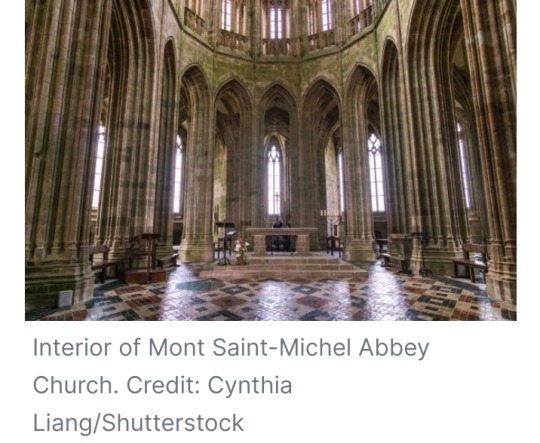
“This edifice is like Noah’s ark laid over the crypts,” said François Saint-James, a guide and lecturer at Mont Saint-Michel, in an interview with Le Devoir newspaper, underlining the architectural prowess required for this medieval project.
“It was a time when France was covered with a white cloak of churches, as a monk from Cluny once wrote. You have to imagine the gigantic scale of the work.
The granite blocks were cut on the Chausey islands, 34 kilometers from here.
Caen stone, a soft, light stone that’s easy to carve, was used. ... When, in the midst of the Hundred Years’ War, the Romanesque choir collapsed, it was rebuilt in flamboyant Gothic style.”
While the abbey’s architectural evolution continued uninterrupted until the 19th century, one of its highest points was the construction of “La Merveille” (The Wonder) in the 13th century, a jewel of Norman Gothic art.
It consists of two buildings on three levels, supported by high buttresses, with a cloister and refectory, 80 meters above sea level, beneath which were built an almshouse, a storeroom, and guest rooms.

The fame of the shrine started to decline in the 17th century, when part of the abbey was turned into a prison by the royal power.
Seized by central government during the revolution, it became a detention center for priests deemed hostile to the Jacobin terror.
In the 19th century, the site, listed as a historic monument in 1874, was gradually returned to monastic life and its original vocation as a sanctuary.
The abbey’s distinctive silhouette was further enhanced by a neo-Gothic spire in 1897, topped by a gilded statue of the archangel.

To mark its 1,000th anniversary, a special tribute is being paid to the abbey that many have dubbed the “Wonder of the West” with the exhibition “La Demeure de l’Archange” (The Archangel’s Abode), retracing its glorious and tumultuous history through some 30 masterpieces, until November 5.
Many of these items, which include sculptures, scale models, statues, and silverware, will be on display to visitors to the abbey for the first time.

Another highlight of the many celebrations taking place over the summer and part of the autumn will be the “Millennium Solstice,” a never-before-seen light show projected onto Mont Saint-Michel from various spots in the bay on the evening of June 23.
The beauty of this sacred site, trodden by millions of pilgrims over the centuries, has been celebrated and immortalized in the writings of many great men of letters over the last few centuries, from Gustave Flaubert to Théophile Gautier and Victor Hugo.
In particular, it inspired the novel “Les Merveilles du Mont Saint-Michel” (1879) by the prolific writer Paul Féval.
He had already paid tribute to the monument a few years earlier, in “La Fée des grèves,” with these lines often quoted by admirers of the famous Mont:
“Twilight broke. Mont-Saint-Michel was the first to emerge from the shadows, offering the golden wings of its archangel to the reflections of the dawning dawn; then the sides of Normandy and Brittany lit up in turn.
Then again, a sort of light steam seemed to rise from the receding sea, and all was veiled except for the statue of Saint Michael, which dominated this wide ocean of mist.”

#Mont Saint-Michel#Khéops of the West#Victor Hugo#UNESCO World Heritage Site#pilgrimage#St. Aubert#Revelation#Mont-Saint-Michel-au-péril-de-la-Mer#Richard I#Duke of Normandy#La Demeure de l’Archange#The Archangel’s Abode#Millennium Solstice#Gustave Flaubert#Théophile Gautier#Paul Féval#Les Merveilles du Mont Saint-Michel#La Fée des grèves#St. Michael the Archangel
28 notes
·
View notes
Text
wasian shadowheart wasian shadowheart waaaaaahhhhhh
#i know i joke abt her being a white girl a lot but the more i think abt it the more wasian shads just make sense to me#me thinking abt chinese pilgrimage stories i read as a kid / had my grandparents telling me before bed#something about her at the gauntlet of shar can be read as like.. almost a subversion of those (im thinking... journey to the west)#anyways !!#❥ 𝐏𝐎𝐒𝐓 ┊ ooc#❥ 𝐒𝐇𝐀𝐃𝐎𝐖𝐇𝐄𝐀𝐑𝐓┊ about
4 notes
·
View notes
Note
So the anthropologist nerd/loser in me wondered what kind of folklore and mythology various alien cultures in the Ben 10 universe might have (creation myths, folk heroes, ways of explaining natural phenomena that aren’t science-based, etc.) and caused me to come up with possibly the dumbest idea for a Ben 10 OC yet: an alien bard who travels across the galaxy not just to perform but also to collect stories and ballads of great events and heroes from different planets to add to their collection and form new ballads based off of them.
One of their original stories tells the tale of an alien from a far-off planet who attempted to take control of the space-time continuum and was cursed by the gods of his planet for his hubris by being scattered across time and space and sent back to the beginning of the universe, forced to live through its entire history in an endless cycle all while never being able to experience the sweet release of death, only for him to learn how to bend time and space to his will and ascend to godhood himself, leading to an epic battle between him and the gods who had cursed him in the first place. Though they are required by the man who served as the inspiration behind the story to put a disclaimer at the beginning that the story is merely a dramatization and doesn't 100% line up with what actually happened before they can tell it.
Oh totally! With the advent of space travel, especially among the species that have had such for a LONG while, there would most certainly be folktales and mythology abound for newer space travelers to pick up. Like, even with a significant scientific understanding of the happenings of the universe, older facts translate into newer fiction as stories develop by word of mouth (or the equivalent depending on species physiology) by the more bardic types of intergalactic individuals.
Of course, you'd probably have the more librarian types who not only record all these tales but also all the fact that it was inspired by through vigorous fact checking. Me making Sugilite a mutant with a more unique planetary psychometry (accessing the 'memories' of the entire planet) lends to me also making him this librarian of Petropian history, and considering the state of Petropia (aka not revived) he can't particularly afford to spin a few myths of his own. Instead Sugilite would totally have some bardic stories ABOUT him and his 'Library of Alexandria' mutant power, especially with Mor'Otesi being as barren of cystalsapiens as it is.
#ask#anoymous#technically this wasn't about him but i brought it up#sugilite#sugilite ben 10#ben 10#even tho galapagus said that his folks sung songs about ben 10's accomplishments i think he's lying#schmooze up to the guy that's CLEARLY important in order to get ben to actually help him and the others#but it's not entirely out of the picture lmao#the entire reason why rook was so excited to meet ben was because of the extranet#heck- ben rook listens to that tokusatsu about ben 10 (if i got that right)#i mean deefus veeblepister is like the most blatant example of 'turning heroes into myth'#even if he was just the main actor of a ben 10 tokusatsu that simian ran#it makes complete sense if there were intergalactic myths that started out as stories based on true events#though it's not quite the same i'm aware that a lot of chinese myths used real people#like the ever famous journey to the west; inspired by the monk Xuanzang's pilgrimage to india#considering that tortugans are advanced enough in space tech to have family species on at least 2 different planets#(that being the pelarotas and the VULPINIC tortugans)#some of the intergalactic myths are modified stories of tortugan historical events#probably to the point that depending on what myth you hear it actually might be tortugan-centric#as opposed to the fault we fall into as human-centric#you might be able to tell when the myth talks about how life on other planets are described tortugan-esque#ben having run into many people try and rip off his story for commercial gain doesn't like it when his story is mythologised#so bards would probably go out of their way to add way too many of their own details so that it doesn't sound the same#which has a problem of being THEIR species-centric take on the hero#it's really fun to imagine
5 notes
·
View notes
Text
Aagaaz Group Marks Guru Purnima at Historic West Bengal Gurudwara
Sikh devotees undertake spiritual journey to Chandrakona for sacred rituals Aagaaz members celebrate Guru Purnima with holy dip and prayers at Chandrakona Gurudwara, a site linked to Guru Nanak Dev Ji’s visit, joining monthly Kirtan Darbar. JAMSHEDPUR – Aagaaz organization members journeyed to Chandrakona Gurudwara Sahib in West Bengal to observe Guru Purnima, partaking in sacred ceremonies. The…
#Aagaaz founder president visit#Aagaaz pilgrimage West Bengal#जनजीवन#Chandrakona Gurudwara holy dip#Eastern India Sikh pilgrims#Guru Nanak Dev Ji historical site#Guru Purnima celebration#Gurudwara Sahib Nanaksar history#Life#monthly Kirtan Darbar Chandrakona#Sikh devotees spiritual journey#Sikh Heritage Preservation
0 notes
Photo

(via The Famous Chicago Rat Hole - Neatorama)
Winslow Dumaine, a comedian, writer, and artist in Chicago, tweeted that he recently made a pilgrimage to the famous Chicago Rat Hole.
This is one of the Windy City's most famous tourist attractions, second only to the Art Institute of Chicago for drawing crowds.
The origins of Chicago Rat Hole are shrouded in mystery. Legend holds that while the concrete for this sidewalk at 1918 West Roscoe Street was being poured, a rat fell in, forever marking the sidewalk with an imprint of its own body. Other Chicagoans contend that it was a squirrel, not a rat.
6K notes
·
View notes
Text
The 1,000-Year-Old Citadel That Rises Out of the Atlantic Ocean
— Aurore Laborie, CNN | Wednesday June 14, 2023
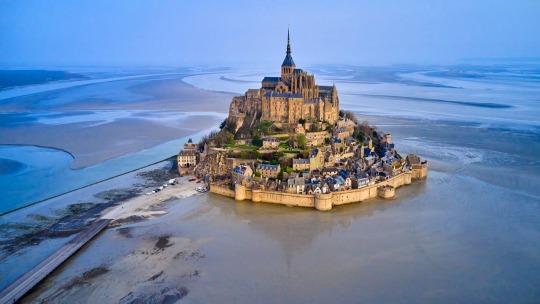
Mont Saint-Michel was once one of the West's biggest pilgrimage sites. Tuul & Bruno Morandi/Digital Vision/Getty Images
Exactly 1,000 years ago this month, construction started on a magnificent island building off the coast of France that, as it rose improbably from the choppy waters of the Atlantic Ocean, would become a lasting symbol of national fortitude.
The medieval abbey atop Mont Saint-Michel, a cascade of walls and buttresses descending from a lofty central spire, was a spectacular creation which has played crucial roles in French history over the centuries.
Today, as it marks a millennium since work began, it’s one of the country’s most popular tourist attractions outside of Paris – at times overwhelmed by its own popularity to such a degree that its custodians have urged people to stay away.
The abbey, which lies off the coast of France’s Normandy region, west of Paris, has pulled in legions of pilgrims over the centuries. Today, it attracts 1.3 million tourists each year.
“In the span of 1,000 years, its silhouette has become an emblem of French universalism,” French President Emmanuel Macron wrote on Twitter on June 5 following an official visit to the site. “Its abbey, the symbol of what we are: a people of builders.”
To celebrate the abbey’s birthday, the Mont is hosting concerts, conferences and a visual show called the “Millennium Solstice” on June 23 that will feature an unprecedented light show. Visitors can also enjoy an exhibition about its history and architecture until November 2023.
A Witness to History
Rising out of a bay flanked by the regions of Normandy and Brittany, surrounded by quicksand, the gothic Mont Saint-Michel abbey towers over its village and thick fortress walls.
When the tide rolls in, the Mont emerges out of the water like a French Atlantis, an architectural wonder set in a beautiful natural landscape. It became a UNESCO World Heritage site in 1979.
A “marriage of human genius and nature,” President Macron commented in a speech celebrating the abbey’s millennium.
Nicknamed the “wonder of the Western world”, the Mont’s history goes back to the year 709 when a sanctuary in honor of Saint Michael the Archangel was erected on the rock. It became a sacred site which continued to evolve from the 11th to the 16th century.
The abbey has witnessed key moments of French history, notably becoming a fortress during the Hundred Years’ War of the 14th and 15th century and surviving a 30-year siege by the British.
It became a prison during the French Revolution of the 18th century. By 1863, 14,000 prisoners had spent time in the “Bastille of the Seas,” where tides and quicksand made escape impossible. Prisoners’ families replaced the pilgrims who had once strolled the village lanes.
It was during the Belle Époque prior to World War I that the monument gradually became the worldwide tourist attraction we know today. One of its popular landmarks is the famous Mère Poulard inn, named after its founder, the brilliant cook Annette Poulard, which has been hosting visitors since 1888.
In 1944, author Ernest Hemingway, at the time a war correspondent, reputedly sat at La Mère Poulard’s table to describe the exploits of the D-day landings, including one of the decisive battles for the liberation of France and Europe, which took place a few kilometers from Mont Saint-Michel, near the completely destroyed town of Avranches.

At peak times, thousands of visitors throng the island's streets. Pierre Longnus/The Image Bank RF/Getty Images
Overtourism Concerns
Mont Saint-Michel has always been extremely popular, attracting millions of pilgrims throughout its history. “It was the biggest pilgrimage site in the West, centuries ago, ahead of Santiago de Compostela,” Thomas Velter, managing director of Mont Saint-Michel National Public Establishment, told CNN.
Nowadays, around 3 million people visit the site every year, with some weekends busier than usual. Ascension weekend in May saw the site overwhelmed by visitors between 11 a.m. and 3 p.m. – a number which alarmed officials usually only expect in peak summer.
“We sold 10,500 tickets at the abbey, which is a record,” Velter told CNN. “Ascension weekend is usually quite busy but in this case, it was a lot of people all at the same time.”
In total, there were around 33,000 people on site, not a record in itself, but still a lot for the Mont, which usually expects this amount of tourists in August, the time of the high season.
“It’s primarily the visitor who suffers because the visit of the Mont is less comfortable,” Velter told CNN. “Ever since Covid, tourists have less tolerance for packed days like this because they were able to taste the joy of visiting sites with barely any visitors.”

French President Emmanuel Macron described the island as a “marriage of human genius and nature.” Arthit Somsakul/Moment RF/Getty Images
With millennium celebrations, initial figures for 2023 suggest that Mont-Saint-Michel will remain a very popular tourist attraction, which poses some problems for its dozen inhabitants, shops and natural landscape.
“I don’t think it’s a good thing for the shopkeepers, hoteliers and restaurants because they simply can’t keep up with the customer demand. Mont Saint-Michel is a square kilometer in circumference, and one shopping street. When you put more than 5,000 people at a specific time on the street, I don’t think it’s very pleasant,” Velter said.
In efforts to increase sustainability, buses connecting the site now run on biofuels rather than diesel. Meanwhile, visitors are urged to explore the wider bay area during the peak 11 a.m. to 3 p.m. hours, and to capitalize on free parking after 6.30 p.m.
“Take advantage of the nature and boat tours we’ve set up, for example. There are seals, eels and Atlantic salmon here,” Velter said. “What we often forget is that there is the largest colony of dolphins in Europe so it’s also a chance to discover Mont Saint-Michel differently.”
0 notes
Text
Welcome to The Journey to the West (西游记) Daily!
You are about to beging a reading journey to get the hidden Buddhist texts accompanied by the monk Tang Sanzang, Sun Wukong, Sha Wujing, Zhu Bajie and Bai Long Ma.
To beging this journey you must subscribe to the newsletter, which you will find at https://journeytothewestdaily.substack.com/. You wil receive your first email this week, welcoming you and sharing information about what's to come and what I will include in the emails.
However, beforehand I want to tell you already that you won't receive a daily email, despite the name of the newsletter. The chapters are dense and full of references to folklore or religion references that you might be unfamiliar with, so you will receive an email every 2 or 3 days maximum.
If this is the first time that you hear about this newsletter and you don't know what Journey to the West is...
The classical Chinese novel Journey to the West is an extended account of the legendary pilgrimage of the Tang dynasty Buddhist monk Xuanzang, who traveled to the "Western Regions" (Central Asia and India) to obtain Buddhist sūtras (sacred texts) and returned after many trials and much suffering. Gautama Buddha gives this task to the monk, whose name in the novel is Tang Sanzang, and provides him with three protectors who agree to help him as an atonement for their sins. These disciples are the Monkey King, Zhu Bajie, and Sha Wujing, together with a dragon prince who acts as the monk's steed, a white horse. The group of pilgrims journey towards enlightenment by the power and virtue of cooperation.
The novel is perfect for the epistolary format, since it's is divided in different and disconnected adventures, so you don't have to always remember what happened in the previous chapter to read the next!
We'll be reading Anthony C. Yu's translation since it is the first unabridged version that we have available in English. It is about 100 chapters long.
As I said, you will receive a first email as soon as you subscribe and an introductory email in a few days. Please, share this post so more people can read along. Use the hashtag #jttwdaily if you want to comment your impressions. I'll share the most important dates soon.
May the Buddha help you in your endeavours.
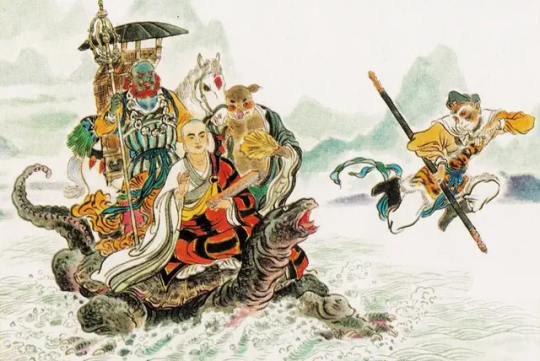
#journey to the west#journey to the West daily#jttwdaily#西游记#Dracula daily#chinese literature#classical Chinese literature#cdrama#the untamed
4K notes
·
View notes
Text
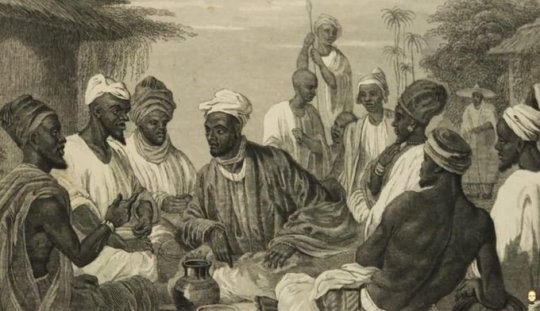
"THERE IS NO GROUP THAT EVER CAME INTO AFRICA THAT MEANT ANYTHING GOOD FOR AFRICANS" -Dr John Henrik Clarke.
“The white man is very clever. He came quietly and peaceably with his religion. We were amused at his foolishness and allowed him to stay. Now he has won our brothers, and our clan can no longer act like one. He has put a knife on the things that held us together and we have fallen apart.” - From 'THINGS FALL APART' 1958, written by Chinua Achebe and was translated into Italian, French, Hungarian, Portuguese, Russian, Swiss, Flemish and other languages.
According to historian, Dr John Henrik Clarke, "every group of people that came into Africa meant nothing good for the Africans… and the very first thing each and every one of these groups did was to declare war on African culture…" What followed was the bastardization of African spirituality and ways that held the societies together for millennia before there was a Greece or Rome or before "the first European learnt to wear a shoe or live in a house that had a window." Or as Dr. Yosef Ben Jochannan put it, "Before there was Rome, Greece, Jerusalem or Mecca… Before there was a Jehovah, Jesus or Mohommet" (Muhammad ibn Abdul'Mutallib).
It most be noted that the first Hebrew to ever come into existence was a Chaldean from Ur, known as Abram in 1675 BC. Before then, their was no concept of a Jehovah or Jesus, whatsoever, and no Hebrew as a tribe, the world over, from as far as history revealed. By this time, the 82 pyramids in Kemet, and the over 203 pyramids in Meroe, the smaller Nsude pyramids in Udi highlands were already built. The Africans had their own spirituality through which they connected to the non-material world, through which they learnt science like iron smelting, as well as which herbs could heal what sort of disease, agricultural practice, astrology, alchemy, mining for useful minerals from the earth and so on.
Most of Africa were connected to the worship of a deity, Ptah. This was over 5000 years before the first Hebrew came into existence, it was thousands of years before Greece or Rome came into existence and before any Abrahamic religions (which are Judaism, Samaritanism, Christianity and Islam etc) came into the knowledge of anyone at all. Abram, the father of it all had not even come into existence.
In kemet, there was a belief that if one died far away from the Nile, one would not resurrect in the afterlife. Hence Kemet became the place of high culture for all tribal nationalities along the Nile from its source through modern day Tanzania, Uganda, Ethiopia Sudan etc. Abydos was a city of pilgrimage where most Africans, who could, travelled up the Nile, through the Sahara (Which was not a desert until about 5000 years ago, as archeological discoveries indicated), to worship and commune with other Africans. Osiris later become the god in Abydos while Memphis became the home for Ptah, after several foreign invasion from across the Mediterranean and the sands of Arabia.
Most of the magicians in Kemet came from Gao, a city-state of the Soudan(west Africa then). African regions and cities had their own gods and it was necessary to pay homage to the god of a land when visiting or passing through as a sojourner, merchant or gypsy. By this time, Arabian peninsula was the colony of Africans (Study from 'From Babylon to Timbuktu', 'The African Origin of Major Religions, Herodoctus, and Strabo's geographica).
{[IMAGE: The 'inner circle' of the Mossi people. Not every king on the throne rose to the societal status, necessary to attend this gathering. The first shattering effect on this 'inner circle' began when the Arabs arrived west Africa in the 7th century CE, while extending the trans-saharan trade routes through the desert.]}
138 notes
·
View notes
Text

Headshot of Etsushir, a soldier chosen to be the personal bodyguard of the sacrificial white calf.
He is somewhat of a rarity among the group, as not only a citizen elowey but of Jazaiti ethnicity, the only historic elowey people in the lands south of the Viper seaway and west of the Blackmane mountains. Jazait are a fairly small population, mostly located on a high, rocky peninsula in the far south of claimed Imperial Wardi lands. The lands themselves are not under direct occupation, but much of Jazaiti fishing and leviathan-hunting waters (on which a huge chunk of subsistence depends) are inaccessible, largely being occupied by Wardi fishing and overseas trade, and fishers must pay tribute in the form of their catch to '''legally''' harvest from most of their own waters. Jazait are somewhat commonly found working as fishers for Wardi cities, but otherwise are largely relegated to the sidelines as a tiny, 'heathen' minority, and will rarely be seen so directly involved in core Imperial Wardi affairs.
Etsushir achieved status as a war hero during the failed suppression of the North Finn rebellion, which he attended as a nameless footsoldier. He was a witness to the Odomache's death and successfully captured two of her killers to be taken alive for execution. This was the only even remotely successful act of retribution for the murder and defilement of The Face Of God Itself, and something he was greatly lauded for, being granted citizenship and a minor lordship (mostly in name alone). If pressed, he will claim to have gotten his dramatic facial scarring during his wartime exploits, but it actually happened two years prior in an accident involving boating equipment.
His status awarded him personal selection by the king to attend the pilgrimage as one of the guards of the sacrificial beasts, assigned to remain at the side of the aurochs calf for the entire duration of the trek. He has received a great privilege of permanently carrying a musket (all but Odonii priestesses and the highest ranking soldiers are prohibited from bearing firearms outside of active combat). He is under very, very, very high pressure to not fuck things up.
Etsushir is quiet and introverted, and rarely speaks unless spoken to. He has spent most of his life predominantly among humans, but never picked up the degree of facial emoting more common to humans than elowey, and is mistaken by many peers for being dull and unresponsive. He is acutely aware that his status is, in large part, an act of showmanship, rewarding a person of one of the most sidelined 'heathen' minorities with great privilege for exemplary loyalty to imperial interests. He trusts next to no one around him.
He is, however, a true believer in the Seven Faced God and the actual goals of the pilgrimage. He comes to truly see his little bovine charge as a piece of God Itself and is very devoted and affectionate towards the calf. He named it, but that's for him and the calf alone to know.
#There's also a Wardi city-state called Jazait (referred to as Jhatsait by Wardi speakers) but it has pretty much no real connection to#the Jazaiti people#Etsushir
251 notes
·
View notes
Text
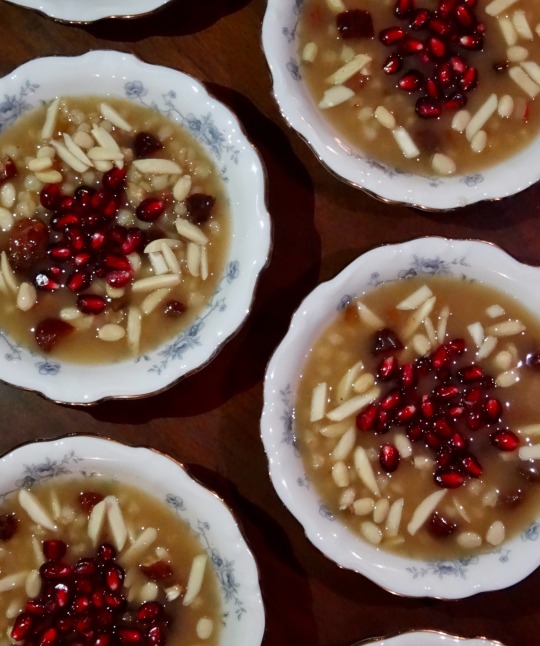

[ID: First image shows four small porcelain bowls of a pudding topped with slivered almonds and pomegranates seeds, seen from above. Second image is an extreme close-up showing the blue floral pattern on the china, slivered almonds, golden raisins, and pomegranate seeds on top of part of the pudding. End ID]
անուշապուր / Anush apur (Armenian wheat dessert)
Anush apur is a sweet boiled wheat pudding, enriched with nuts and dried fruits, that is eaten by Armenians to celebrate special occasions. One legend associates the dish with Noah's Ark: standing on Mt. Ararat (Արարատ լեռը) and seeing the rainbow of God's covenant with humanity, Noah wished to celebrate, and called for a stew to be prepared; because the Ark's stores were diminishing, the stew had to be made with small amounts of many different ingredients.
The consumption of boiled grains is of ancient origin throughout the Levant and elsewhere in West Asia, and so variations of this dish are widespread. The Armenian term is from "անուշ" ("anush") "sweet" + "ապուր" ("apur") "soup," but closely related dishes (or, arguably, versions of the same dish) have many different, overlapping names.
In Arabic, an enriched wheat pudding may be known as "سْنَينِيّة" ("snaynīyya"), presumably from "سِنّ" "sinn" "tooth" and related to the tradition of serving it on the occasion of an infant's teething; "قَمْح مَسْلُوق" ("qamḥ masluq"), "boiled wheat"; or "سَلِيقَة" ("salīqa") or "سَلِيقَة القَمْح" ("salīqa al-qamḥ"), "stew" or "wheat stew," from "سَلَقَ" "salaqa" "to boil." Though these dishes are often related to celebrations and happy occasions, in some places they retain an ancient association with death and funerary rites: qamh masluq is often served at funerals in the Christian town of بَيْت جَالَا ("bayt jālā," Beit Jala, near Bethlehem).
A Lebanese iteration, often made with milk rather than water, is known as "قَمْحِيَّة" ("qamḥīyya," from "qamḥ" "wheat" + "ـِيَّة" "iyya," noun suffix).
A similar dish is known as "بُرْبَارَة" ("burbāra") by Palestinian and Jordanian Christians when eaten to celebrate the feast of Saint Barbara, which falls on the 4th of December (compare Greek "βαρβάρα" "varvára"). It may be garnished with sugar-coated chickpeas and small, brightly colored fennel candies in addition to the expected dried fruits and nuts.
In Turkish it is "aşure," from the Arabic "عَاشُوْرَاء" ("'āshūrā"), itself from "عَاشِر" ("'āshir") "tenth"—because it is often served on the tenth day of the month of ٱلْمُحَرَّم ("muḥarram"), to commemorate Gabriel's teaching Adam and Eve how to farm wheat; Noah's disembarkment from the Ark; Moses' parting of the Red Sea; and the killing of the prophet الْحُسَيْن بْنِ عَلِي (Husayn ibn 'Ali), all of which took place on this day in the Islamic calendar. Here it also includes various types of beans and chickpeas. There is also "diş buğdayı," "tooth wheat" (compare "snayniyya").
These dishes, as well as slight variations in add-ins, have varying consistencies. At one extreme, koliva (Greek: "κ��λλυβα"; Serbian: "Кољиво"; Bulgarian: "Кутя"; Romanian: "colivă"; Georgian: "კოლიო") is made from wheat that has been boiled and then strained to remove the boiling water; at the other, Armenian anush apur is usually made thin, and cools to a jelly-like consistency.
Anush apur is eaten to celebrate occasions including New Year's Eve, Easter, and Christmas. In Palestine, Christmas is celebrated by members of the Armenian Apostolic church from the evening of December 24th to the day of December 25th by the old Julian calendar (January 6th–7th, according to the new Gregorian calendar); Armenian Catholics celebrate on December 24th and 25th by the Gregorian calendar. Families will make large batches of anush apur and exchange bowls with their neighbors and friends.
The history of Armenians in Palestine is deeply interwoven with the history of Palestinian Christianity. Armenian Christian pilgrimages to holy sites in Palestine date back to the 4th century A.D., and permanent Armenian monastic communities have existed in Jerusalem since the 6th century. This enduring presence, bolstered by subsequent waves of immigration which have increased and changed the character of the Armenian population in Palestine in the intervening centuries, has produced a rich history of mutual influence between Armenian and Palestinian food cultures.
In the centuries following the establishment of the monasteries, communities of Armenian laypeople arose and grew, centered around Jerusalem's Վանք Հայոց Սրբոց Յակոբեանց ("vank hayots surbots yakobeants"; Monastery of St. James) (Arabic: دَيْر مَار يَعْقُوب "dayr mār ya'qūb"). Some of these laypeople were descended from the earlier pilgrims. By the end of the 11th century, what is now called the Armenian Quarter—an area covering about a sixth of the Old City of Jerusalem, to the southwest—had largely attained its present boundaries.
Throughout the 16th and 17th centuries, the Patriarchate in Jerusalem came to have direct administrative authority over Armenian Christians across Palestine, Lebanon, Egypt, and Cyprus, and was an important figure in Christian leadership and management of holy sites in Jerusalem (alongside the Greek Orthodox and Roman Catholic churches). By the middle of the 19th century, a small population of Armenian Catholics had joined the larger Armenian Apostolic community as permanent residents in Jerusalem, living throughout the Muslim Quarter (but mostly in a concentrated enclave in the southwest); in the beginning of the 20th century, there were between 2,000 and 3,000 Armenians of both churches in Palestine, a plurality of whom (1,200) lived in Jerusalem.
The Turkish genocide of Armenians beginning in 1915 caused significant increases in the populations of Armenian enclaves in Palestine. The Armenian population in Jerusalem grew from 1,500 to 5,000 between the years of 1918 and 1922; over the next 3 years, the total number of Armenians in Palestine (according to Patriarchate data) would grow to 15,000. More than 800 children were taken into Armenian orphanages in Jerusalem; students from the destroyed Չարխափան Սուրբ Աստվածածին վանք (Charkhapan Surb Astvatsatsin Monastery) and theological seminary in Armash, Armenia were brought to the Jerusalem Seminary. The population of Armenian Catholics in the Muslim Quarter also increased during the first half of the 20th century as immigrants from Cilicia and elsewhere arrived.
The immediate importance of feeding and housing the refugees despite a new lack of donations from Armenian pilgrims, who had stopped coming during WW1—as well as the fact that the established Armenian-Palestinians were now outnumbered by recent immigrants who largely did not share their reformist views—disrupted efforts on the part of lay communities and some priests to give Armenian laypeople a say in church governance.
The British Mandate, under which Britain assumed political and military control of Palestine from 1923–1948, would further decrease the Armenian lay community's voice in Jerusalem (removing, for example, their say in elections of new church Patriarchs). The British knew that the indigenous population would be easier to control if they were politically and socially divided into their separate religious groups and subjected to the authority of their various religious hierarchies, rather than having direct political representation in government; they also took advantage of the fact that the ecclesiastical orders of several Palestinian Christian sects (including the Armenian Patriarchate of Jerusalem) comprised people from outside of Palestine, who identified with religious hierarchy and the British authorities more than they identified with the Palestinian lay communities.
British policy, as well as alienating Armenians from politics affecting their communities, isolated them from Arab Palestinians. Though the previously extant Armenian community (called "քաղաքացի" "kaghakatsi," "city-dwellers") were thoroughly integrated with the Arab Palestinians in the 1920s, speaking Arabic and Arabic-accented Armenian and eating Palestinian foods, the newer arrivals (called "زُوَّار" / "զուվվար" "zuwwar," "visitors") were unfamiliar with Palestinian cuisine and customs, and spoke only Armenian and/or Turkish. Thus British policies, which differentiated people based on status as "Arab" (Muslim and Christian) versus "Jewish," left new Armenian immigrants, who did not identify as Arab, disconnected from the issues that concerned most Palestinians. They were predominantly interested in preserving Armenian culture, and more concerned with the politics of the Armenian diaspora than with local ones.
Despite these challenges, the Armenian Patriarchate of Jerusalem came to be a vital center of religious and secular culture for the Armenian diaspora during the British Mandate years. In 1929, Patriarch Yeghishe Turian reëstablished the Սուրբ Յակոբեանց Տպարան ("surbots yakobeants taparan"; St. James printing house); the Patriarchate housed important archives relating to the history of the Armenian people; pilgrimages of Armenians from Syria, Lebanon, and Egypt increased and the economy improved, attracting Armenian immigrants in higher numbers; Armenians held secular roles in governance, policing, and business, and founded social, religious, and educational organizations and institutions; Armenians in the Old and New Cities of Jerusalem were able to send financial aid to Armenian victims of a 1933 earthquake in Beirut, and to Armenians expelled in 1939 when Turkey annexed Alexandretta.
The situation would decline rapidly after the 1947 UN partition resolution gave Zionists tacit permission to expel Palestinians from broad swathes of Palestine. Jerusalem, intended by the plan to be a "corpus separatum" under international administration, was in fact subjected to a months-long war that ended with its being divided into western (Israeli) and eastern (Palestinian) sections. The Armenian population of Palestine began to decline; already, 1947 saw 1,500 Armenians resettled in Soviet Armenia. The Armenian populations in Yafa and Haifa would fall yet more significantly.
Still, the Armenian Patriarchate of Jerusalem maintained its role as the center of Armenian life in Palestine; the compound provided food and shelter to thousands of Armenians during the Battle for Jerusalem and the Nakba (which began in 1948). Some Armenians formed a militia to defend the Armenian Quarter against Haganah shelling during the battle.
In the following years, historical British contributions to the shoring up of insular power in the Patriarchate would cause new problems. The Armenian secular community, no longer empowered to oversee the internal workings of the Patriarchate, could do nothing to prevent embezzling, corruption, and even the sale of church-owned land and buildings to settlers.
In 1967, Israeli military forces annexed East Jerusalem, causing another, albeit smaller, surge in Armenian emigration from the city. Daphne Tsimhoni estimates based on various censuses that the Armenian population of Jerusalem, which had reached 5,000-7,000 at its peak in 1945–6, had fallen back to 1,200 by 1978.
Today, as in the 20th century, Armenians in Jerusalem (who made up nearly 90% of the Armenian population of Palestine as of 1972) are known for the insularity of their community, and for their skill at various crafts. Armenian food culture has been kept alive and well-defined by successive waves of immigrants. As of 2017, the Armenian Patriarchate supplied about 120 people a day with Armenian dishes, including Ղափամա / غاباما "ghapama" (pumpkin stuffed with rice and dried fruits), թոփիկ / توبيك "topig" (chickpea-and-potato dough stuffed with an onion, nut, fruit, and herb filling, often eaten during Lent), and Իչ / ايتش "eetch" (bulgur salad with tomatoes and herbs).
Restaurants lining the streets of the Armenian and Christian quarters serve a mixture of Armenian and Palestinian food. Լահմաջո "lahmadjoun" (meat-topped flatbread), and հարիսա / هريس "harisa" (stew with wheat and lamb) are served alongside ֆալաֆել / فلافل ("falafel") and մուսախան / مسخن ("musakhkhan"). One such restaurant, Taboon Wine Bar, was the site of a settler attack on Armenian diners in January 2023.
Up until 2023, despite fluctuations in population, the Armenian community in Jerusalem had been relatively stable when compared to other Armenian communities and to other quarters of the Old City; the Armenian Quarter had not been subjected to the development projects to which other quarters had been subjected. However, a deal which the Armenian Patriarchate had secretly and unilaterally made with Israel real estate developer Danny Rotham in 2021 to lease land and buildings (including family homes) in the Quarter led Jordan and Palestine to suspend their recognition of the Patriarch in May of 2023.
On 26th October, the Patriarchate announced that it was cancelling the leasing deal. Later the same day, Israeli bulldozers tore up pavement and part of a wall in حديقة البقر ("ḥadīqa al-baqar"; Cows' Garden; Armenian: "Կովերի այգու"), the planned site of a new luxury hotel. On 5th November, Rothman and other representatives of Xana Gardens arrived with 15 settlers—some of them with guns and attack dogs—and told local Armenians to leave. About 200 Armenian Palestinians arrived and forced the settlers to stand down.
On 12th and 13th November, the developer again arrived with bulldozers and attempted to continue demolition. In response, Armenian Palestinians have executed constant sit-ins, faced off against bulldozers, and set up barricades to prevent further destruction. The Israeli occupation police backed settlers on another incursion on 15th November, ordering Armenian residents to vacate the land and arresting three.
On December 28th, a group of Armenian bishops, priests, deacons, and seminary students (including Bishop Koryoun Baghdasaryan, the director of the Patriarchate's real estate department) were attacked by a group of more than 30 people armed with sticks and tear gas. The Patriarchate attributed this attack to Israeli real estate interests trying to intimidate the Patriarchate into abandoning their attempt to reverse the lease through the court system. Meanwhile, anti-Armenian hate crimes (including spitting on priests) had noticeably increased for the year of 2023.
These events in Palestine come immediately after the ethnic cleansing of Լեռնային Ղարաբաղ ("Lernayin Gharabagh"; Nagorno-Karabakh); Israel supplied exploding drones, long-range missiles, and rocket launchers to help Azerbaijan force nearly 120,000 Armenians out of the historically Armenian territory in September of 2023 (Azerbaijan receives about 70% of its weapons from Israel, and supplies about 40% of Israel's oil).
Support Palestinian resistance by donating to Palestine Action’s bail fund; buying an e-sim for distribution in Gaza; or donating to help a family leave Gaza.
Ingredients
180g (1 cup) pearled wheat (قمح مقشور / խոշոր ձաւար), soaked overnight
3 cups water
180-360g (a scant cup - 1 3/4 cup) sugar, or to taste
Honey or agave nectar (optional)
1 cup total diced dried apricots, prunes, golden raisins, dried figs
1 cup total chopped walnuts, almonds, pistachios
1 tsp rosewater (optional)
Ceylon cinnamon (դարչին) or cassia cinnamon (կասիա)
Aniseed (անիսոն) (optional)
Large pinch of salt
Pomegranate seeds, to top (optional)
A Palestinian version of this dish may add pine nuts and ground fennel.
Pearled wheat is whole wheat berry that has gone through a "pearling" process to remove the bran. It can be found sold as "pearled wheat" or "haleem wheat" in a halal grocery store, or a store specializing in South Asian produce.
Amounts of sugar called for in Armenian recipes range from none (honey is stirred into the dish after cooking) to twice the amount of wheat by weight. If you want to add less sugar than is called for here, cook down to a thicker consistency than called for (as the sugar will not be able to thicken the pudding as much).
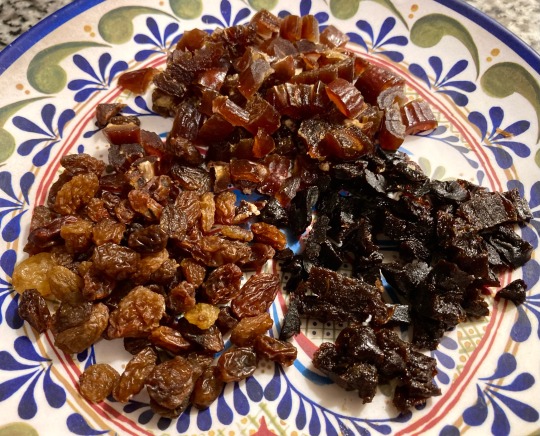
Instructions
1. Submerge wheat in water and scrub between your hands to clean and remove excess starch. Drain and cover by a couple inches with hot water. Cover and leave overnight.
2. Drain wheat and add to a large pot. Add water to cover and simmer for about 30 minutes until softened, stirring and adding more hot water as necessary.

Wheat before cooking

Wheat after cooking
3. Add dried fruit, sugar, salt, and spices and simmer for another 30 minutes, stirring occasionally, until wheat is very tender. Add water as necessary; the pudding should be relatively thin, but still able to coat the back of a spoon.
4. Remove from heat and stir in rosewater and honey. Ladle pudding into individual serving bowls and let cool in the refrigerator. Serve cold decorated with nuts and pomegranate seeds.
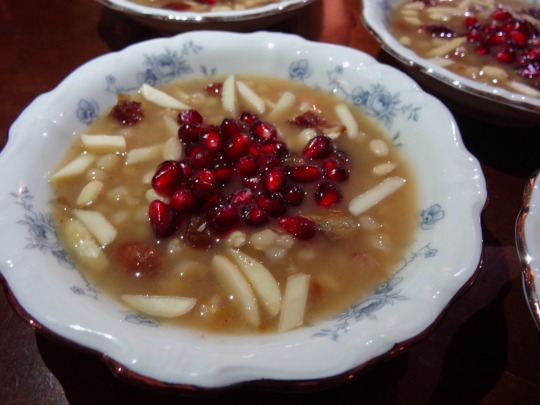
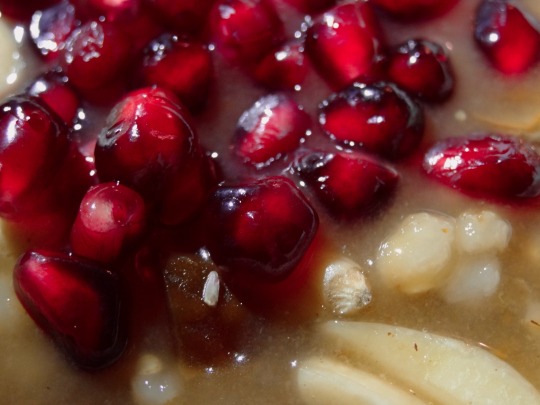
#the last link is a different / new fundraiser#Armenian#Palestinian#fusion#wheat berries#pearled wheats#pomegranate#prunes#dried apricot#dates#long post /
376 notes
·
View notes